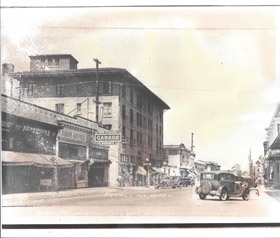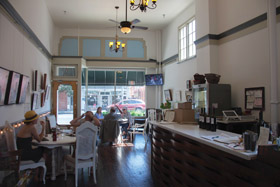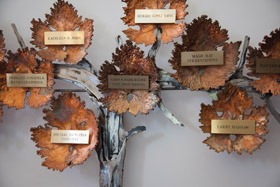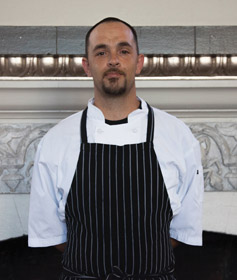 Before Kickstarter, churches were the kings of crowdfunding. Instead of practicing mandatory tithes in the United States, churches would pass the offering plate among the congregation during the weekly (or biweekly) sermon. Hands would dip into purses and wallets, and the familiar plink, plink, plink of metal on metal signaled the latest contribution, as spare change and parking funds eventually returned to the front of the altar before the end of the sermon.
Before Kickstarter, churches were the kings of crowdfunding. Instead of practicing mandatory tithes in the United States, churches would pass the offering plate among the congregation during the weekly (or biweekly) sermon. Hands would dip into purses and wallets, and the familiar plink, plink, plink of metal on metal signaled the latest contribution, as spare change and parking funds eventually returned to the front of the altar before the end of the sermon.
Before the code word in the pastor’s speech, signaling the altar boys to bring the plate forward, the pastor would announce the purpose for this week’s collection: fixing the leaky roof; a new synthesizer to replace the broken organ; helping a congregation member get through hard times. And like the economy as a whole, members used dollars to voice their approval.
A secular version of community-based funding came to Sonoma County in 1923, when 855 men and women pooled their money to build the town’s second hotel. Unbeknownst to them, this action set an attitude in the small town: If we want it, we’ll put our money forward to have it. Nearly a century later, in the same location of their “crowdfunded hotel,” new businesses funded by community dollars breathe new life into one of the city’s oldest buildings.
Hotel Petaluma
1923 was a busy year in America. President Warren Harding died, leaving the presidency to Calvin Coolidge; the first Yankee Stadium opened in the Bronx; a giant sign appeared on the hills of Southern California with the word “Hollywoodland”; a small magazine called Time opened its doors; and Petaluma residents finally collected $250,000 among themselves to fulfill a $350,000 cost to build a hotel. According to save.org, an inflation estimate of $250,000 in 1923 has the buying power of $3,498,000 in 2016.
Petaluma itself was in the early stages of flowering into the city it is today. Established during the California Gold Rush of the 1840s, the town became a prominent stop for gold-panners and other fortune-finders heading north due to the namesake river that flows through its limits. By the turn of the century, Petaluma’s population neared 6,000 and, after a fire consumed the first hotel on the site (known as the Brooklyn), the community banded together to create a 100-room, five-story hotel, the largest building in town at the time. Soon, traveling salesmen and working class commuters kept occupancy high, while San Francisco residents made the drive north to enjoy ballroom dances and other fine amenities.
“Made possible through the cooperative effort of eight hundred and fifty five men and women of Petaluma. Its friendly doors welcome the stranger and under its hospitable roof the friends of Petaluma find always only goodwill. It stands as evidence and proof of the faith which the people of Petaluma have in each other and in their city,” reads the bronze plaque next to the lobby entrance.
The recent history of the hotel has been a far cry from the lavish reputation of its former self. Classified as a residence hotel, the rooms were available on a month-to-month basis, offering little more than a bed and toilet. Services were communal, and shared and half-bathrooms were common. Its low-income revenue stream caused the hotel to become synonymous with the transient and the poor, and for years the corner of Kentucky and East Washington Street attracted the kind of crowd that caused pedestrians to cross the street to avoid the building. Instead of the crown jewel of the town it once was, the building seemed destined to die a slow, undignified death, unworthy of the community that brought it life.
 Enter Dipak Patel and Satish Patel (no relation), the San Francisco businessmen with more than 40 years of hotel management experience who took ownership in April 2015. The Patels saw what the building was and resolved to resurrect its spirit. The duo brought new management, including Dustin Groff as general manager, to oversee construction by CPE Construction from Galt, Calif. “The scope of the construction itself is huge,” Groff says, “but how to blend the modern while retaining the splendor of the original building was also a challenge. It’s been quite a challenge, but the place looks so beautiful right now, even though it’s not finished yet.”
Enter Dipak Patel and Satish Patel (no relation), the San Francisco businessmen with more than 40 years of hotel management experience who took ownership in April 2015. The Patels saw what the building was and resolved to resurrect its spirit. The duo brought new management, including Dustin Groff as general manager, to oversee construction by CPE Construction from Galt, Calif. “The scope of the construction itself is huge,” Groff says, “but how to blend the modern while retaining the splendor of the original building was also a challenge. It’s been quite a challenge, but the place looks so beautiful right now, even though it’s not finished yet.”
Groff worked in the hotel’s marketing and operations department with OptiRev before taking the general manager position May 1, 2016. This is his first general manager position, but he learned the ropes of hospitality at Vintners Inn and John Ash. “Percy Brandon [general manager at Vinters Inn] is a real mentor to me, and the way he operates inspires me to provide the best service possible for the hotel’s guests. Holly Michalek [CEO of OptiRev] is another mentor and played a huge part in me becoming GM,” Groff says.
As of September 2016, construction has moved away from the lobby and up to the rooms. Groff says the European-style communal bathrooms are gone, and each room will have modern amenities like individually controlled air conditioning and heating and smart televisions. “Comfort is the number one priority in this hotel,” Groff says. “We want our guests to not only enjoy the retro feel of the building but also be comfortable with modern luxuries in their rooms. They want a nice, comfortable bed; a television to wind down with in the evening and their own bathroom. These are the changes we’re most excited about.”
In addition to the restored ballroom (with a private conference room above, named the Brooklyn Boardroom in honor of the predecessor hotel) and the revival of the original outdoor fountain courtyard entrance (complete with a set of handmade double doors to match the original front doors) in the front, the new Hotel Petaluma will also have a rooftop lounge, which is only accessible through a flight of stairs and the fifth floor features half the usual number of rooms. “The top floor has an exclusive feel to it, and even though guests can’t use an elevator to get their luggage up to the last floor, they tell us they love the view,” Groff says. The elevator itself is a relic from the old days, the first passenger elevator in Petaluma. Groff reports they’ll keep the feel of the old elevators for nostalgic purposes (including manually operated doors), but they plan to recable and restore the motors to pristine condition before construction ends, in addition to reviving the ascetics of the elevator’s interior.
Barber Cellars
 While impressive on its own, no hotel is worth its salt without a bevy of entertainment options to support it. The downtown location was one of the main reasons Michael and Lorraine Barber chose to start their Barber Cellars tasting room there in 2015. “We thought the hotel would bring some traffic from tourists and guests at the hotel—and boy, was that right,” Lorraine says. “Business has been very good here.”
While impressive on its own, no hotel is worth its salt without a bevy of entertainment options to support it. The downtown location was one of the main reasons Michael and Lorraine Barber chose to start their Barber Cellars tasting room there in 2015. “We thought the hotel would bring some traffic from tourists and guests at the hotel—and boy, was that right,” Lorraine says. “Business has been very good here.”
The husband and wife duo started with a non-commercial wine in their home in 2005. “If you want to laugh at other people’s physical pain, I’d recommend watching a bunch of people trying to move a quarter-ton of grapes into a two-story walk-up apartment in San Francisco,” Lorraine laughs. “We sterilized the kitchen and we sterilized a friend’s legs, then we started crushing grapes. We kept everything in our tiny closet. The fermentation fumes almost drove us out of the apartment. When the barrel had to be rehydrated, we sprayed it in the bathtub.”
After nearly gassing the entire apartment complex with fumes, the Barbers finally had their own Sangiovese, which never went for sale. Their first Zinfandel, named Mr. Beast in honor of their ferocious housecat, was made in 2006 and became the flagship wine in their inventory. “We had a family friend paint a portrait of Mr. Beast and used that on our label until 2009, when the New York Times wrote a blanket piece that said every wine with an animal on the label was immediately garbage,” Michael says. “We changed the label after that.”
Tasting commercial success with wholesale selling to bars, restaurants and specialty stores, the Barbers believed a brick-and-mortar location was the right move for the growth of their business. “With small wineries, the tasting room can account for nearly all wine sales,” Michael says. “I’m a firm believer that every winery should have its own tasting room. It promotes the brand and introduces the wine to the general public.”
Opening a Kickstarter campaign in Spring 2015, the Barbers met their $20,000 goal and opened their tasting room adjoining the hotel, with access to and from the lobby through a side door. The Barbers showcase their wines paired with locally sourced food. The charcuterie comes from Zoe’s Farms. Cheese makers include Cowgirl Creamery. The bread is from local bakeries. The grapes are from the Sonoma Mountain and Petaluma Gap AVAs. “Once per month, we host a night with local cheesemakers,” Lorraine says. “We organize a wine pairing for the guests while they try out the cheeses on display. We sell out every time.” Other entertainment includes a challenge from Michael: Nobody can beat his score on the Donkey Kong machine they keep in the tasting room. “Anyone who beats my store will get a free bottle of wine for the achievement,” he boasts. “We have a lot of classic cabinet games on that machine. We had a guy come in just to get on the board for Galaga.”
tasting room adjoining the hotel, with access to and from the lobby through a side door. The Barbers showcase their wines paired with locally sourced food. The charcuterie comes from Zoe’s Farms. Cheese makers include Cowgirl Creamery. The bread is from local bakeries. The grapes are from the Sonoma Mountain and Petaluma Gap AVAs. “Once per month, we host a night with local cheesemakers,” Lorraine says. “We organize a wine pairing for the guests while they try out the cheeses on display. We sell out every time.” Other entertainment includes a challenge from Michael: Nobody can beat his score on the Donkey Kong machine they keep in the tasting room. “Anyone who beats my store will get a free bottle of wine for the achievement,” he boasts. “We have a lot of classic cabinet games on that machine. We had a guy come in just to get on the board for Galaga.”
The Oyster Girls
 The newest addition to the Kentucky Street corner is the city’s first seafood and raw bar. Named The Shuckery, the restaurant plays homage to its founders’ roots. “We started our business as The Oyster Girls,” explains Aluxa Lalicker, co-owner of The Shuckery with her sister, Jazmine (Jaz) and executive chef Seth Harvey. “Oyster shucking had a very masculine stereotype, where only large, strong men can shuck oysters for parties. But the oyster itself is a very feminine animal, and I thought, ‘Why not combine the femininity of the oyster with our own?’ That was one of the inspirations behind starting The Oyster Girls.”
The newest addition to the Kentucky Street corner is the city’s first seafood and raw bar. Named The Shuckery, the restaurant plays homage to its founders’ roots. “We started our business as The Oyster Girls,” explains Aluxa Lalicker, co-owner of The Shuckery with her sister, Jazmine (Jaz) and executive chef Seth Harvey. “Oyster shucking had a very masculine stereotype, where only large, strong men can shuck oysters for parties. But the oyster itself is a very feminine animal, and I thought, ‘Why not combine the femininity of the oyster with our own?’ That was one of the inspirations behind starting The Oyster Girls.”
The sisters opened the company in 2008 with oysters farmed from Tomales Bay Oyster Company. The Oyster Girls are for-hire for private events, decked in cocktail dresses, oyster in one hand, knife in the other. In addition to singular events, Aluxa and Jaz shuck oysters on Mondays at Iron Horse Vineyards, providing the briny seashore treats to wine-and-diners.
“We’d been shucking and catering events every week for eight years until, for the first time, we felt like we needed a break,” says Jaz. The girls decided to pool their money and take a vacation to the undisputed kingpin of oyster consumption: New Orleans. “We had oysters for breakfast, lunch and dinner every day we were there,” Aluxa laughs. “They never got boring, and it reignited a passion for oysters within us. We came back refreshed and ready for our next project.”
needed a break,” says Jaz. The girls decided to pool their money and take a vacation to the undisputed kingpin of oyster consumption: New Orleans. “We had oysters for breakfast, lunch and dinner every day we were there,” Aluxa laughs. “They never got boring, and it reignited a passion for oysters within us. We came back refreshed and ready for our next project.”
The next step, according to the sisters, was inspired by a trend they observed in New Orleans. “We’ve dreamed of having a brick and mortar restaurant and oyster bar for a long time,” Aluxa says. “When a space in the historic Hotel Petaluma became available we knew it was the right space for us.” After a conversation and sales pitch with the Patels, the spot on the corner was theirs.
A Kickstarter campaign started August 2016 with a $25,000 goal to cover the cost of bringing the space up to code, but the project fell short of the required funds and wasn’t fulfilled. “While we didn’t meet that goal, we were still funded by family and friends,” Aluxa says. “It won’t stop the construction or opening, but we’ll have wait on a few dream projects.”
Aluxa met Harvey when the three were providing catering and aqualife tours in Tomales Bay with Blue Waters Kayaking in Inverness. Aluxa led kayakers to a remote beach where Harvey and a catering crew would cook meals while Aluxa shucked oysters.
 Harvey was in Delaware, cooking Cajun comfort foods on the East Coast when the Lalickers came to him with a proposal and a contract. “We weren’t sure if he was going to relocate across the country for us, but he did it in a heartbeat, without a second thought. That’s when we knew we had the right chef. We knew Seth [Harvey] is a master at seafood, and we couldn’t think of a better fit for The Shuckery,” Jaz says. “Expect a lot of incredibly fresh seafood at the raw bar, as well as some dishes I learned working on the East Coast,” Harvey says.
Harvey was in Delaware, cooking Cajun comfort foods on the East Coast when the Lalickers came to him with a proposal and a contract. “We weren’t sure if he was going to relocate across the country for us, but he did it in a heartbeat, without a second thought. That’s when we knew we had the right chef. We knew Seth [Harvey] is a master at seafood, and we couldn’t think of a better fit for The Shuckery,” Jaz says. “Expect a lot of incredibly fresh seafood at the raw bar, as well as some dishes I learned working on the East Coast,” Harvey says.
In addition to Harvey, the Lalickers have hired Jeremy Utterback as sous chef. Utterback’s culinary career spans across Sonoma County, including Santa Rosa’s La Gare restaurant at Railroad Square and the Santa Rosa Seafood Raw Bar and Grill.
The crown jewels
With the new Hotel Petaluma, Barber Cellars and The Shuckery, the corner on Kentucky and East Washington is undergoing a transformation. Previous years of quiet acknowledgement for a run-down residence hotel in dire need of repairs are over. Now, Petalumans can look forward to once more enjoying a grand ballroom adjacent to a premiere tasting room and seafood and raw bar, all boosted to their spots by community funds. “It’s time for a new era at this downtown spot,” Groff says. “It’s another place Petalumans can be proud of while they spend some time with their neighbors.”
The Crowd(funding) Goes Wild
While the idea of community funding is as old as the idea of community itself, the phenomenon of Internet-based crowdfunding didn’t take flight until 2009, when Kickstarter (www.kickstarter.com ) opened its doors. The New York-based company’s plan to make money by helping other people make money became a beacon for independent creatives and entrepreneurs looking to sell their ideas to a global audience.
Kickstarter may have opened the door, but the concept really took off when other companies offered a different way to pay. Instead of investing in a specific product, San Francisco-based Patreon (www.patreon.com) lets investors pay artists directly, receiving exclusive tier-leveled rewards based on the monthly amount given. Twitch.tv (www.twitch.tv), a subsidiary of Amazon, uses a subscription system that directly supports videogame streamers, supplementing (and, in the most successful cases, surpassing) ad revenue. IndieGoGo (www.indiegogo.com) and GoFundMe (www.gofundme.com) use Kickstarter’s pay-for-project model, but patrons don’t necessarily expect rewards in return. These forums are for funding projects like emergency medical treatments or other services like disaster relief.
Above and Beyond Expectations
The following are examples of some of the most successful campaigns in crowdfunding history, either through total dollars raised or percentage of dollars raised over the goal.
Potato Salad by Zack “Danger” Brown (Kickstarter): The $25 goal to make a batch of potato salad ended its campaign with $55,500 instead. Brown rented out a park and hosted a potato salad party for everyone who invested.
Crash Course (Patreon): More than 7,000 patrons collectively give The Fault in Our Stars author John Green and his Crash Course team $28,000 per month to make more YouTube videos.
Star Citizen (Kickstarter): A modest $500,000 campaign to launch an ambitious videogame has instead raised more than $77 million.
Support Victims of Pulse Club Shooting (GoFundMe): There have been campaigns across all crowdfunding platforms to give medical and financial aid to the victims of the Pulse Nightclub shooting in Orlando, Flor., but this $7million project is by far the largest.
Exploding Kittens (Kicksarter): This card game from the minds of Elan Lee, Shane Small and The Oatmeal’s Matthew Inman holds the record for most number of backers for a single campaign: 219,382 backers with nearly $8.8 million in funding for the $10,000 project.
Our Own Angels
Not all donors are individuals. Angel funding describes a person or group of persons who invest seed money into projects for equity when the project meets success down the line. The North Bay Angels is a forum for active angel investors to meet entrepreneurs in the North Bay who need investment capital and mentoring to succeed. Successful projects the North Bay Angels have funded include the Altwork Station; a fully motorized chair that shifts the body to sitting, reclining, standing and even zero gravity conditions. Other angel investment groups are available for projects and entrepreneurs who rely on a local angle to start their business, and might not interest a global market. (See “Expertise: North Bay Angels,” Game Changers 2014.)



